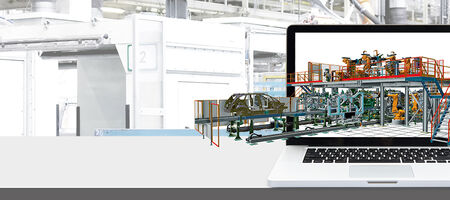The three pillars of digital twins
... and what advantages they bring to virtual commissioning
![[Translate to EN:] three pillars for the creation of a digital twin three pillars for the creation of a digital twin](/fileadmin/_processed_/3/6/csm_drei-saeulen-digitaler-zwilling-en_01_b033c8ed47.jpg)
The simulation solution fe.screen-sim differs in many essential points from other tools that are used to create plant models and the associated virtual commissioning. A decisive difference in the direct comparison of different simulation tools is the separation between signals, behavior models and visualization or physics in fe.screen-sim.
Why is this separation into "three pillars" important and where are the advantages?
For better clarification, the facts with regard to the differences between the real plant and the digital twin are explained in more detail below using a simple example:
In reality, for example, a motor is controlled by an output from the programmable logic controller (PLC). In the simplest case, the control functions like a simple contactor circuit. The motor in turn sets a conveyor belt in motion for a material transport, for example.
In the virtual environment, the PLC also sends an output signal and the above-mentioned contactor circuit is defined in a behavior model. This behavioral model then provides an output signal with an actual speed for the conveyor line represented in the 3D model.
Thus, the division of signals, behavior models and visualization or physics into three separate areas implemented in fe.screen-sim brings a number of decisive advantages:
- Signal processing is uniform and independent of the source system. This means that it does not matter from which participants (PLC, robot, database, subsystems, etc.) the signals are read or written. The communication partners can also exchange signals with each other without any problems.
- If, for example, 3D visualization is not necessary for testing the PLC program, it does not have to be used. At this point, for example, it is also possible to create a very simplified (idealized) model in fe.screen-sim. Thus, in the end, the user himself decides which level of detail - and thus which creation and time effort - is necessary and reasonable for the simulation.
- Behavioral models can be used - independent of physical properties - at any point of the model for material conveyors, motion axes, clamping devices, etc., thus considerably reducing the effort required for model creation.
Another advantage is the library included in fe.screen-sim with a large number of ready-made behavioral models, which can be used immediately and without much effort for the creation of the digital twin.
Would you like to learn more about virtual commissioning and the associated benefits in your projects? Give us a call, we will be happy to present the possibilities to you.
Your personal contact person – for more clearness
You are a project or department manager and are faced with the question of how to set up a digital twin for your project? We would be happy to talk to you personally about your requirements, the time frame, the possible project approach and give you an initial cost estimate.


